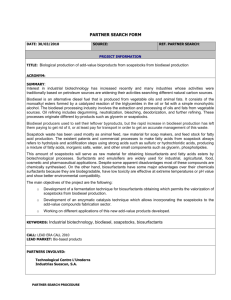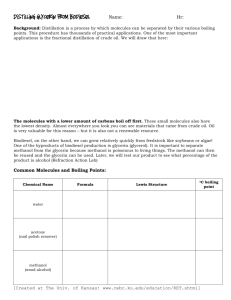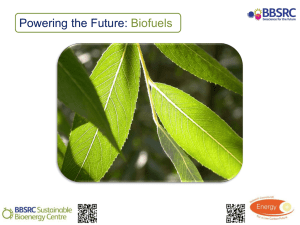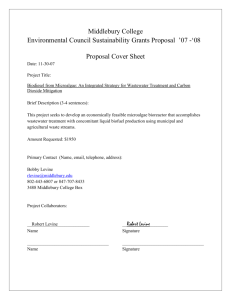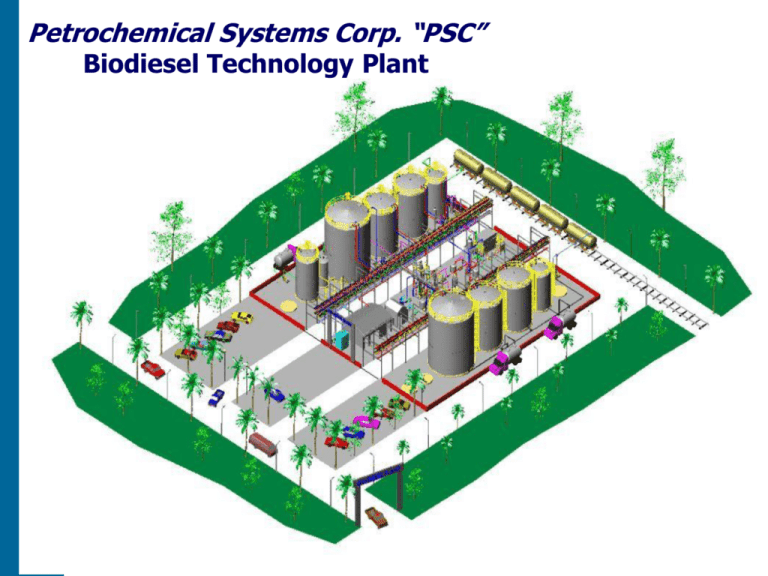
Petrochemical Systems Corp. “PSC”
Biodiesel Technology Plant
What is Biodiesel ?
A fuel comprised of mono-alkyl esters of long chain fatty acids derived
from vegetable oils OR animal fats designated B100, and meet the
requirements of ASTM D 6751.
Methyl Ester
It contains no petroleum but can be blended with petroleum diesel.
It runs in diesel engines, reduces emissions, reduces oil dependence
and meets Federal Standards.
Biodiesel vs. Petroleum Diesel
Biodiesel yields 3.2 units of fuel energy whereas Petroleum Diesel
yields 0.83 units of fuel energy per unit of fossil energy consumed.
Biodiesel emits 78.5% less CO2 than Petroleum Diesel. The blend
exhibits proportionate benefits i.e. B20 emits 15.66% less CO2 than
Petroleum Diesel.
Significant emission reductions in CO, CO2, unburned hydrocarbons,
particulate matter, ozone formation and reduction in cancer risk.
Why PSC ?
Over 30 years of experience in Design / Build Projects of Distillation, Evaporation
and Recovery Systems associated with the petrochemical industry. Over 40 years
combined engineering knowledge
Process Design using Simulation Software – ChemCAD & HYSYS.
Engineering Expertise including Mechanical, Piping, Instrumentation, Chemical,
Process, Electrical, Controls, and Structural.
Installation and Start-up Expertise in State-of-the-Art Industrial Automation &
Controls.
Experienced manpower in Biodiesel Plant Operation, Maintenance, Monitoring
and Optimization
Optional process for faster Transesterification such as Ultrasonication
Conversion.
PSC’ Engineering Capability
Electrical
Process
Purchasing
Project Management
Controls
Construction Management
Mechanical
Chemical
Civil
Structural
Instrumentation
PSC’ Technical Support Capabilities
Lab testing
P&ID development
Pre-commissioning support
Service support
Training & Development
Remote engineering
assistance
Conceptual process
evaluation
Process simulation
Operator training
Start-up assistance
Field service support
Project management
Process of PSC Technology
Pretreatment with Acid Esterification
Continuous flow
Trans-esterification using a Bio-Conversion Processor (BCP)
Continuous flow / Waterless
Biodiesel Refining (ASV)
Methanol separation from Glycerin and Water (SRXC)
Recovered Methanol is reused in the process
Glycerin produces is non-hazardous
Post treatment using dry wash applications
Biodiesel Process Flow
Oil Feed
System
Acid
Catalyst
Esterification
Alkali
Catalyst
Virgin Oil
Methanol
Transesterification
Treated Oil
Crude
Glycerin
Methanol
Recovery
Glycerin
Refining
(SRXC)
Dry Glycerin
Crude
Biodiesel
Biodiesel
Refining
(ASV)
Methanol
+ Water
to SRXC
Post
Treatment
Dry Wash
Crude
Glycerin
Biodiesel
Pretreatment / Esterification
Methanol & acid are mixed and injected into oil stream
Mixture is heated to 140°F - 175°F. and reacted in the tubular reactor
After Esterification, dry glycerin is added and mixed with oil-methanol
stream while cooling to 140°F.
Light layer and heavy layers are separated with the help of Centrifuge
Light layer is ready for Transesterification
Esterification
Transesterification
Transesterification is based on the chemical reaction of triglycerides with
Methanol to form methyl esters and glycerin in the presence of an alkaline
catalyst
Methanol & Catalyst are injected into Light layer from esterification and
virgin oil and reacted in the Bio-Conversion Processor (BCP)
Crude Biodiesel and Crude Glycerin are separated using Centrifuge after
completion of the transesterification reaction
Crude Biodiesel and Crude Glycerin are refined using distillation columns
Use of Ultrasonication Conversion can speed up this process significantly.
Bio Conversion Processor (BCP)
Biodiesel Refining (ASV)
Crude Biodiesel from Transesterification is refined from Methanol and
Water
By controlling the process parameters, Biodiesel is separated from the
distillation column bottom
Biodiesel is then further purified with post treatment, or the final
washing process
Methanol along with water separated from the biodiesel by ASV
column is then further processed to recover Methanol in the SRXC to
provide high purity Methanol for reuse
ASV System
ASV System
Glycerin Processing (SRXC)
Crude Glycerin from Transesterification and Methanol / Water stream
from ASV unit is refined in the distillation column for Methanol reuse
at 99.9% purity
By controlling the process parameters of column, Glycerin, water,
and neutralized catalyst are discharged at a flash point above 140°F.
Glycerin recovered from this process is NON-HAZARDOUS and can be
easily stored and transported, or can be further refined
Methanol is recovered from the top of the column and reused in the
plant processes
SRXC System
SRXC System
(Dual Column Design)
Typical HMI Screen
(DCS with Optimization)
Typical HMI Screen
Remote Control
Post Treatment / Dry Wash
Biodiesel produced is treated using “Dry Washing” to remove
impurities
Benefits of Dry Washing
Reduced waste water
Faster wash times
Improved fuel quality
Features of PSC Biodiesel Plants
Prefabricated modular units for modular growth.
Optimization of the process using PSC licensed software.
Field Instrumentation communication using Profibus.
Plant controlled by a Distributed Control System (DCS)
Assistance in engineering of tank farm, buildings, and site
infrastructure.
Project management, start-up, operation assistance, day-to-day plant
operations.
Ultrasonic Transesterification of Oil to
Biodiesel
Ultrasonication increases the chemical
reaction speed of the transesterification of
vegetable oils and animal fats into
biodiesel. This allows to change the
production from batch processing to
continuous flow processing and it reduces
investment and operational costs.
Biodiesel Conversion using Ultrasonication
Continuous Processing and Separation
In a setup for the continuous processing and continuous
separation, the heated oil and the catalyst premix are mixed together
continuously using adjustable pumps. An inline static mixer improves
the homogeneity of the feed to the ultrasonic flow cell. The oil/catalyst
mixture passes the flow cell, where it is being exposed to ultrasonic
cavitation for approx. 5 to 30 seconds. A backpressure valve is
used to control the pressure in the flow cell. The sonicated mix enters
the reactor column on the top. The volume of the reactor column is
designed to give approx. 1 hour retention time in the column.
During that time, the transesterification reaction is completed. The
reacted biodiesel/glycerin mix is pumped to the centriguge where it is
separated into the biodiesel and glycerin fractions. Post-processing
involves alcohol recovery, washing and drying and can be done
continuously, too.
This setup eliminates reactor batches, conventional agitators and
large separator tanks.
Algae Cultivation system
Algae oil is an interesting sustainable feedstock for biodiesel
manufacturing. It is an alternative to popular feedstocks, like
soybean, canola and palm. Ultrasonication improves the extraction
of oil from the algae cells and the conversion to biodiesel.
In comparison to traditional oil-seed crops, algae yields much more oil
per acre. While soybean typically produces less than 50 gallon of oil per
acre and rapeseed generates less than 130 gallon per acre, algae can
yield up to 20,000 gallons per acre. In particular diatoms and green
algae are good sources for the production of biodiesel.
Like other plants, algae stores energy in the form of lipids. There are
various methods for extracting the oils, such as pressing, hexane
solvent wash and ultrasonic extraction.
Cultivation system* development
Concept:
• bubble column reactors for continuous inoculation
• open cascade of increasing surface area
>> supply effluents
• “once through” hydraulic regime
>> no backmixing
>> no build up of contaminants (< 0.02%)
• adequate mixing required large-scale selective cultivation AND water purification
at acceptable cost
Integral system (concept)
•system simplification; cost-and energy reduction
Algae Bond Cultivation
Yield of Various Plant Oils
Crop
Castor
Sunflower
Safflower
Palm
Soy
Coconut
Algae
Oil in Liters per hectare
1413
952
779
5950
446
2689
100000
Comparison of average oil yields from algae with that from other oilseeds
The table above presents indicative oil yields from various oilseeds and algae. Please note that there are
significant variations in yields even within an individual oilseed depending on where it is grown, the specific
variety/grade of the plant etc. Similarly, for algae there are significant variations between oil yields from different
strains of algae. The data presented above are indicative in nature, primarily to highlight the order-of-magnitude
differences present in the oil yields from algae when compared with other oilseeds.
Typical Way That
SAHARA GROUP UK
PSC Builds
Biodiesel Plants
Copyright
Copyright 2008 Petrochemical systems Corporation. All rights reserved.
All the text, graphics, design and other works on this presentation are the copyrighted works of
Petrochemical systems Corporation. This legal protection does also apply for data or similar
institutions. The contents of this presentation may be sighted and downloaded for the private
(not for commercial) use, but are otherwise in no way allowed to be reproduced, passed, re-used,
alienated, stored, altered, spread or otherwise used without our previous written allowance. Our
internet pages can partly contain contents which are subject to the copyright of those who
provide these contents. Brands, company logos and illustrations included on this presentation are
protected for us and/or (where stated) for those companies which are associated with us and are
therefore not allowed to be used for ones own or other purposes.
Contact Information
SAHARA GROUP UK
PSC
UK
Tel: +44 7798701465
Tel:+442086862443



